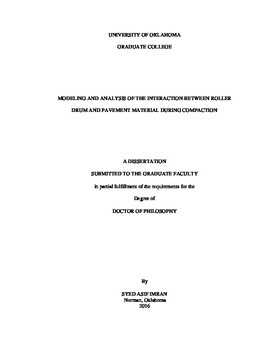| dc.description.abstract | The problem of ensuring real time control of compaction quality during pavement construction is considered in this dissertation. Asphalt pavements are complex, multilayer, heterogeneous structures where different layers of asphalt mixes are often placed on top of and supported by a base subgrade layer. In order to ensure long term performance of these pavements, it is imperative to ensure proper quality in both the subgrade and the asphalt layer during their construction. Compaction is one of the important steps in pavement construction that significantly affects the quality and long term performance of the pavement. Proper and uniform compaction of the subgrade and asphalt layers during construction is necessary for the pavement to support the expected traffic load over its lifetime. Inadequate compaction of asphalt layers could result in a pavement with insufficient stiffness leading to problems such as reduced fatigue life, accelerated aging/decreased durability, rutting, raveling, and moisture damage. The underlying subgrade also needs sufficient compaction to ensure adequate load bearing capacity of the pavement and reduce its susceptibility to moisture and other weather-related distresses.
Although the impact of compaction on the performance and longevity of pavements is well understood, addressing compaction issues during construction is not easy given the limitations in the available quality control tools. The traditional QC methods rely on in situ measurement devices that provide an estimate of compaction quality at discrete test locations and generally cover less than 1% of the entire pavement area. Therefore, it is not possible to address under-compaction in areas other than those identified at the test locations. Besides, the tests are time consuming, expensive, and often destructive in nature. In order to overcome these limitations, ‘Intelligent Compaction (IC)’ methods have been proposed to provide 100% coverage of the pavement surface during compaction. These methods analyze the vibrations of roller drum and provide an estimate of the stiffness of the compacted pavement material. Further, these systems have integrated Global Position Sensors (GPS) and computational devices that record the spatial location of the roller and the stiffness values continuously during compaction. One major limitation in the available IC technologies is that they provide the estimation of pavement quality in terms of vendor specific values and do not provide estimates in terms of any of the parameters used in the design of the pavement. The relationship between these measurement values and accepted measures such as modulus or pavement density is also not well established. Limitations in the understanding on the coupled dynamics between a vibratory roller and lack of mathematical framework hamper the research and validation of the IC technologies.
In this dissertation, the limitations of the IC technologies in quality control of asphalt compaction are addressed through the development of a mathematical model to study and analyze the interaction between a moving vibratory roller and the underlying asphalt pavement. A lumped element modelling approach is adopted and the vibration of the roller drum, its movement along and interaction with the pavement are formulated by mathematical equations. The asphalt pavement is represented by a collection of blocks of mechanical elements arranged in a grid wise manner with each block exhibiting visco-elastic and plastic properties. The asphalt model parameters are estimated from the results of standard laboratory complex modulus test. These parameters account for the effect of pavement temperature, layer thickness, loading frequency and volumetric properties of asphalt mix. Numerical simulations are performed to study the ability of the model to replicate the results of field compaction. Comparison of the model simulation results with field compaction data shows that the model can emulate the salient characteristic vibratory response of the drum observed during field compaction. The results also indicate that the model is able to replicate the pass by pass densification process during field compaction. Analyses of the results show that the model can be used to account for the asphalt-roller interaction in both the vertical and the horizontal directions.
The development of an intelligent compaction technology for real time control of subgrade quality is also addressed in this dissertation. An Artificial Neural Network (ANN) based intelligent compaction system is developed to estimate the stiffness of the subgrade during compaction. The ANN classifies the vibrations of the roller drum during compaction into known patterns. Details of the pavement under compaction and the classified patterns are then used together to estimate the stiffness of the layer. A calibration procedure is developed that can adjust the IC parameters to minimize the error between the IC estimated stiffness values and in-situ measurements taken after the pavement is fully compacted. The system was tested and validated during four different construction projects. The results indicate that the system is capable of real time estimation of subgrade stiffness with accuracy suitable for contractor’s quality control operations. Field investigations also indicate that the system can be used for detecting under-compacted regions of subgrade in real time, thereby allowing remedial actions to be performed.
Improving the overall quality of pavement during construction will improve its performance and service life and reduce the cost to maintain it over its lifetime. It will help to improve driver safety by providing a smooth, stable and skid resistant surface for the vehicle. Sustainable pavements will also reduce the impact of road construction on the environment. | en_US |
